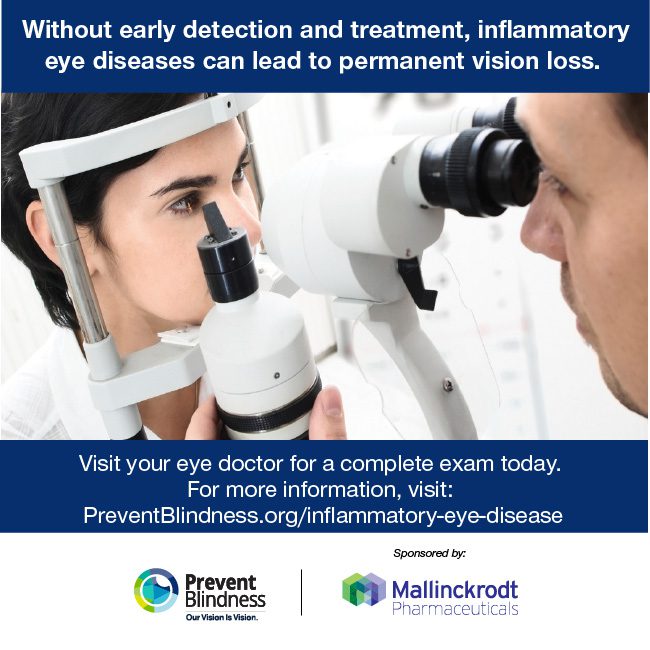National Non-profit group, Prevent Blindness, is Promoting Awareness and Education on Inflammatory Eye Disease and the Steps That Should Be Taken to Save Sight
In an effort to educate the public on the various forms of Inflammatory Eye Disease (IED), Prevent Blindness has declared Sept. 27 – Oct. 3, 2021, as the first-ever Inflammatory Eye Disease Awareness Week. Early detection and treatment of IED can significantly reduce vision loss.
As part of this initiative, Prevent Blindness has created a dedicated webpage providing detailed information on IED, downloadable fact sheets in English and Spanish, and resources for eye care. Additionally, shareable social media graphics will be posted on the Prevent Blindness social media channels throughout the week. Development of these new resources was supported by a grant from Mallinckrodt Pharmaceuticals.
 Prevent Blindness will feature a new episode in its Focus on Eye Health Expert Series, with an interview of Dr. Ann-Marie Lobo of the Illinois Eye and Ear Infirmary, Associate Professor of Ophthalmology, Co-Director, Uveitis Service, University of Illinois College of Medicine, Department of Ophthalmology and Visual Sciences. Her area of expertise is diagnosis and treatment of patients with ocular inflammatory and infectious diseases. Also included is a patient interview with Addison Schwaller, Emergency Medicine Physician Assistant at Logansport Memorial Hospital in Logansport, Ind. Ms. Schwaller shares her experience of living with pars planitis, a form of uveitis.
Prevent Blindness will feature a new episode in its Focus on Eye Health Expert Series, with an interview of Dr. Ann-Marie Lobo of the Illinois Eye and Ear Infirmary, Associate Professor of Ophthalmology, Co-Director, Uveitis Service, University of Illinois College of Medicine, Department of Ophthalmology and Visual Sciences. Her area of expertise is diagnosis and treatment of patients with ocular inflammatory and infectious diseases. Also included is a patient interview with Addison Schwaller, Emergency Medicine Physician Assistant at Logansport Memorial Hospital in Logansport, Ind. Ms. Schwaller shares her experience of living with pars planitis, a form of uveitis.
Eye inflammation occurs in response to infection, allergies, autoimmune disorders, irritation, injury, or trauma to the eyes, eyelids, or surrounding tissues. Different parts of the eye can be affected, depending on the cause of the inflammation. Eye inflammation is common and can happen at any age. The length of time of the eye inflammation and treatment will depend on the type and severity of the underlying disease, disorder or condition. Most cases of eye inflammation can be successfully treated. However, in rare cases there can be a serious disease present, which is a threat to the eyesight.
Different types of IED include:
Uveitis– can occur in one eye or both eyes and affects the layer of the eye called the uvea. It also can be associated with inflammation of other parts of the eye and last for a short (acute) or a long (chronic) time.
Keratitis– also known as “corneal ulcer”, is an inflammation of the cornea – the clear, dome shaped window located at the front of the eye that covers the iris and pupil. Keratitis resulting from infections (called infectious keratitis) can be caused by bacteria, viruses, fungi, and parasites.
Conjunctivitis– or pink eye, is an inflammation of the conjunctiva, the clear mucous membrane that covers the white part of the eyeball and the inside of the eyelid. It is the most common eye infection in the United States.
Thyroid Eye Disease– sometimes called Graves’ ophthalmopathy or Graves’ Eye Disease, is an autoimmune disease in which the immune system causes inflammation and swelling and stimulates the production of muscle tissue and fat behind the eye. The overactive thyroid gland (hyperthyroidism) is usually caused by Graves’ disease.
“As with most eye diseases and conditions, access to quality eyecare and treatment can help prevent vision loss and even blindness from Inflammatory Eye Disease,” said Jeff Todd, president and CEO of Prevent Blindness. “Making eye health a priority today protects our sight now and into the future.”
For more information on inflammatory eye disease, please visit https://preventblindness.org/inflammatory-eye-disease.
For a listing of vision care financial assistance programs in English or Spanish, visit https://www.preventblindness.org/vision-care-financial-assistance-information.
Download the Inflammatory Eye Disease Awareness Week press release.

